Albert Paley’s Cross Currents
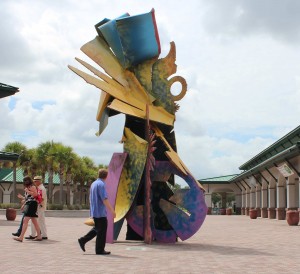 Located at the entry to Florida Gulf Coast University’s courtyard is a formed and fabricated steel sculpture called Cross Currents. It soars 21 feet and ten inches into the brilliant southwest Florida sky. At first glance, you might think this 8 x 12 foot wide, 17, 000-pound structure is just a jumble of colorful shapes. But as you stare, the serrated teeth of an open-mouthed alligator, shards of sunlight, the fringe of palm fronds and the rough silhouette of a palm trunk slowly emerge
Located at the entry to Florida Gulf Coast University’s courtyard is a formed and fabricated steel sculpture called Cross Currents. It soars 21 feet and ten inches into the brilliant southwest Florida sky. At first glance, you might think this 8 x 12 foot wide, 17, 000-pound structure is just a jumble of colorful shapes. But as you stare, the serrated teeth of an open-mouthed alligator, shards of sunlight, the fringe of palm fronds and the rough silhouette of a palm trunk slowly emerge 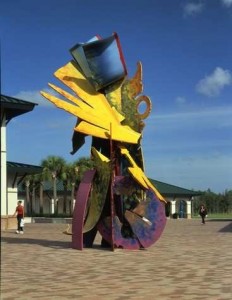 from this abstract, modernist piece.
from this abstract, modernist piece.
The sculpture is the work of world-renowned artist Albert Paley, the first metal sculptor to ever receive the coveted the AIA Lifetime Achievement Award, the highest honor awarded by the American Institute of Architects to a non-architect. “The allure of Paley’s art comes though its intrinsic sense of integration of art and architecture,” one noted architect has stated, and that is certainly true of Cross Currents, a work Paley completed in 2001.
Paley not only employed an expressionist style in his sculpture’s 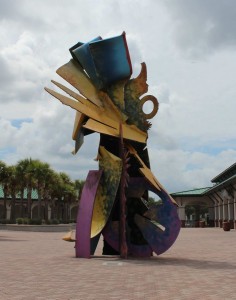 design, he repeated that theme as he hand-painted Cross Current‘s component pieces in bright Florida colors: flamingo pink, sky blue and the yellows, reds and oranges associated with the Gulf Coast’s colorful sunsets. “He applied two coats of UV protection,” notes FGCU Associate Arts Professor Morgan T. Paine. But the colors have nevertheless faded under the merciless onslaught of southwest Florida’s near-equatorial sun. [Compare photos 2 and 3.] “The colors are not as vibrant as they were when the sculpture first arrived on the FGCU campus,” Paine observes with obvious regret. “We’re trying to figure out whether we can strip off the existing UV coats and buff out the
design, he repeated that theme as he hand-painted Cross Current‘s component pieces in bright Florida colors: flamingo pink, sky blue and the yellows, reds and oranges associated with the Gulf Coast’s colorful sunsets. “He applied two coats of UV protection,” notes FGCU Associate Arts Professor Morgan T. Paine. But the colors have nevertheless faded under the merciless onslaught of southwest Florida’s near-equatorial sun. [Compare photos 2 and 3.] “The colors are not as vibrant as they were when the sculpture first arrived on the FGCU campus,” Paine observes with obvious regret. “We’re trying to figure out whether we can strip off the existing UV coats and buff out the 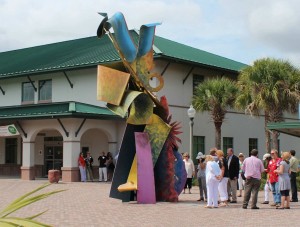 colors embedded in the metal.” If not, it will be challenging to restore Cross Currents‘ vitality while yet preserving Paley’s painterly expressionist style.
colors embedded in the metal.” If not, it will be challenging to restore Cross Currents‘ vitality while yet preserving Paley’s painterly expressionist style.
Perhaps the artist will have his own ideas about how to conserve the piece without compromising its integrity. Paley is known to visit southwest Florida frequently, although he has only seen 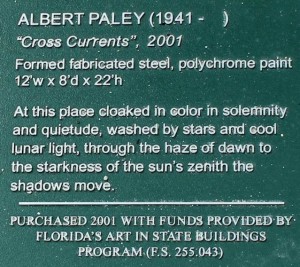 Cross Currents once since it was installed on the Florida Gulf Coast University campus in 2001.
Cross Currents once since it was installed on the Florida Gulf Coast University campus in 2001.
Cross Currents is part of the Florida Art in Public Buildings program, an initiative started in 1979 pursuant to section 255.043 of the Florida Statutes, which earmarks 0ne-half of one percent of the amount the legislature appropriates for the construction of state buildings for the acquisition of public artworks.
Why Albert Paley
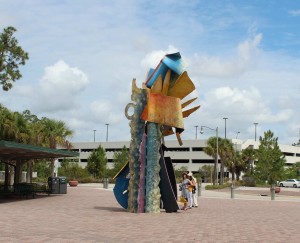 It was truly remarkable for Florida Gulf Coast University to attract a monumental artist of Albert Paley’s credentials, accomplishments and reputation. But he was not simply given the commission. Paley’s name was placed in nomination by Karl H. Hollander, the executive director of the Lee County Alliance for the Arts at the time. A sculptor himself, Hollander was familiar with Paley’s body of work, especially gates
It was truly remarkable for Florida Gulf Coast University to attract a monumental artist of Albert Paley’s credentials, accomplishments and reputation. But he was not simply given the commission. Paley’s name was placed in nomination by Karl H. Hollander, the executive director of the Lee County Alliance for the Arts at the time. A sculptor himself, Hollander was familiar with Paley’s body of work, especially gates 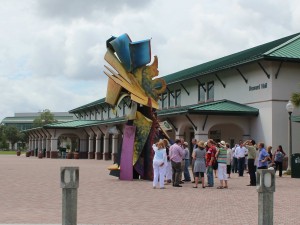 he made for the Patty & Jay Naples Museum of Art and bronze ribbon handles he crafted for the lobby doors of the Naples Philharmonic Center for the Arts (see below).
he made for the Patty & Jay Naples Museum of Art and bronze ribbon handles he crafted for the lobby doors of the Naples Philharmonic Center for the Arts (see below).
Paley submitted a maquette for the consideration of the 5-member selection committee, which consisted of two members of the arts committee, an architect, a representative of the building where 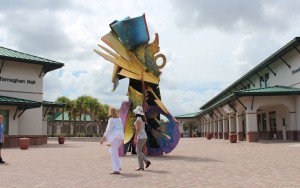 the public artwork would be installed and a representative of the FGCU president’s office. Paley’s design edged out those submitted by two other renowned finalists, Bruce White and David Black (who recently installed Fire Dance in Centennial Park, the most recent addition to the City of Fort Myers public art collection).
the public artwork would be installed and a representative of the FGCU president’s office. Paley’s design edged out those submitted by two other renowned finalists, Bruce White and David Black (who recently installed Fire Dance in Centennial Park, the most recent addition to the City of Fort Myers public art collection).
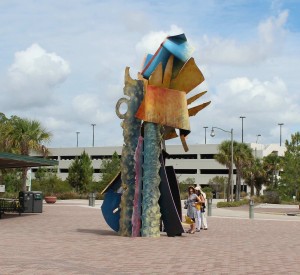 Paley originally designed Cross Currents to go in the mall between the library and Reed Hall. However, a controversy ensued regarding that location, which was not resolved until Paley hopped a plane to Fort Myers so that he could meet personally with FGCU President, Dr. William Merwin. “Paley walked the campus with Dr. Merwin,” recalls FGCU Associate Professor of Arts Morgan T. Paine, “and the two finally agreed that the sculpture would be placed at the east entrance
Paley originally designed Cross Currents to go in the mall between the library and Reed Hall. However, a controversy ensued regarding that location, which was not resolved until Paley hopped a plane to Fort Myers so that he could meet personally with FGCU President, Dr. William Merwin. “Paley walked the campus with Dr. Merwin,” recalls FGCU Associate Professor of Arts Morgan T. Paine, “and the two finally agreed that the sculpture would be placed at the east entrance 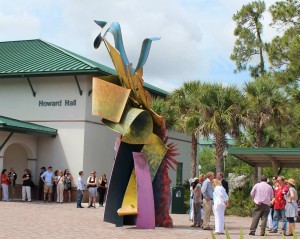 to the campus even though it was designed to be surrounded by greenery instead of being sandwiched between two buildings.” As a result, Cross Currents installed in the mall between Howard Hall and McTarnaghan Hall on the eastern entry to the long courtyard that spans the center of the FGCU campus.
to the campus even though it was designed to be surrounded by greenery instead of being sandwiched between two buildings.” As a result, Cross Currents installed in the mall between Howard Hall and McTarnaghan Hall on the eastern entry to the long courtyard that spans the center of the FGCU campus.
Other Paley Public Artworks in Southwest Florida
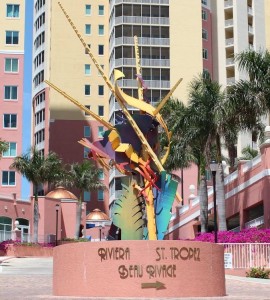 Southwest Florida has four other of Paley’s monumental works:
Southwest Florida has four other of Paley’s monumental works:
- Completed in 2009, Naiad graces the entrance of the St. Tropez and Beau Rivage condominium complexes. Now part of the City of Fort Myers’ public art collection, the sculpture was originally commissioned by Riviera Development Group, which opted to install its own public artwork rather than make a cash donation to the city’s public art fund. The metal sculpture stands on a stuccoed, raised circular pedestal set in the center of a bricked turnaround at
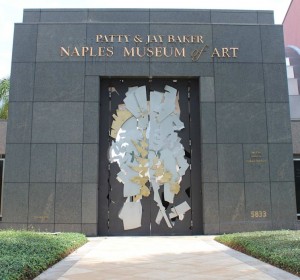 the front entrance of the St. Tropez, which is located at 2745 First Street. Naiad’s color scheme matches and complements the yellow over-and-white over salmon of the condominiums that tower high above it.
the front entrance of the St. Tropez, which is located at 2745 First Street. Naiad’s color scheme matches and complements the yellow over-and-white over salmon of the condominiums that tower high above it. - At the gray marble entry to the Patty & Jay Baker Naples Museum of Art stand The Paley Gates, an exceptional example of the unique portals, passageways and thresholds long associated with the art of Albert Paley. The gates
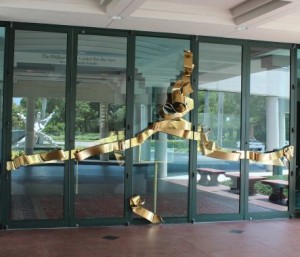 are 16 feet tall by 10 feet wide, although only the bottom half swing open to admit visitors into the courtyard leading to the museum. Endowed by Michael and Deborah Stephens, the steel, bronze and stainless steel gates were installed in 2000.
are 16 feet tall by 10 feet wide, although only the bottom half swing open to admit visitors into the courtyard leading to the museum. Endowed by Michael and Deborah Stephens, the steel, bronze and stainless steel gates were installed in 2000. - Paley also created ornate handles for the lobby doors of the Philharmonic Center for the Arts. Known for his inventive and novel approach to both metalsmithing and jewelry design, Paley
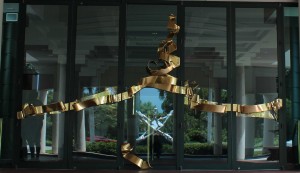 cut the Phil’s door handles in the form of a bronze ribbon that both commemorates events at the Center and suggests an experience in time. A fallen piece of ribbon or banner is a recurring theme in the sculptures Paley crafts as rites of passages for visitors entering a building.
cut the Phil’s door handles in the form of a bronze ribbon that both commemorates events at the Center and suggests an experience in time. A fallen piece of ribbon or banner is a recurring theme in the sculptures Paley crafts as rites of passages for visitors entering a building.
More about Albert Paley
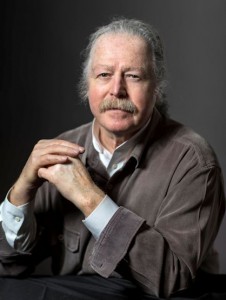 Over the past three decades, Albert Paley has created monumental site-specific metal assemblages that place him not only in the forefront of contemporary sculpture, but in the vanguard among artists working in the new, genre-defying area that has been called “Archisculpture.” Paley goes beyond creating sculptures that stand as isolated works of art. His sculptures enhance the spaces in which they are placed and, in return, are enhanced by those spaces. He has established himself as an artist who constantly pushes boundaries, questions old categories and redefines himself in his own distinctive idiom, at once visionary and persuasively tangible.
Over the past three decades, Albert Paley has created monumental site-specific metal assemblages that place him not only in the forefront of contemporary sculpture, but in the vanguard among artists working in the new, genre-defying area that has been called “Archisculpture.” Paley goes beyond creating sculptures that stand as isolated works of art. His sculptures enhance the spaces in which they are placed and, in return, are enhanced by those spaces. He has established himself as an artist who constantly pushes boundaries, questions old categories and redefines himself in his own distinctive idiom, at once visionary and persuasively tangible.
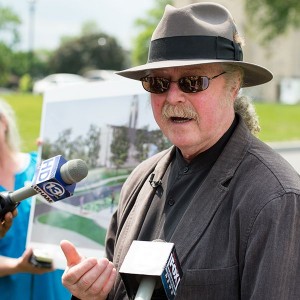 Paley emerged in the mid-1960s as an artist goldsmith, and within a decade he became involved with the forging of steel. He is a long-standing leader in the metal sculpture arena, where he is widely recognized for evolving blacksmithing into the realm of public art and commissions. He has continually pushed the boundaries of his work, its process and materials through several contexts. Forging steel in a form of plasticity and pliability, Paley addresses the transformational change of the material through
Paley emerged in the mid-1960s as an artist goldsmith, and within a decade he became involved with the forging of steel. He is a long-standing leader in the metal sculpture arena, where he is widely recognized for evolving blacksmithing into the realm of public art and commissions. He has continually pushed the boundaries of his work, its process and materials through several contexts. Forging steel in a form of plasticity and pliability, Paley addresses the transformational change of the material through 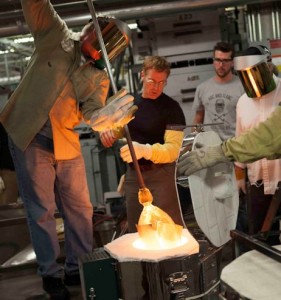 tapering, swaging, splitting, upsetting and punching. The result is sculpture developed of organic form analogous to processes seen in nature, such as the development of organic form in response to gravity with the emphasis on transition through the quality of line, and his use of steel has been described as industrial poetry.
tapering, swaging, splitting, upsetting and punching. The result is sculpture developed of organic form analogous to processes seen in nature, such as the development of organic form in response to gravity with the emphasis on transition through the quality of line, and his use of steel has been described as industrial poetry.
Commissioned by both public institutions and private corporations, Paley has completed more than 60 site-specific works (see below). Some notable examples are the Portal Gates for the Renwick Gallery of the 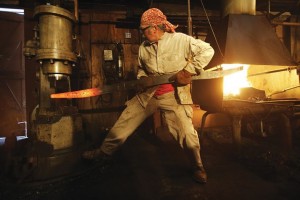 Smithsonian Institution in Washington D.C., Synergy, a ceremonial archway in Philadelphia, the Portal Gates for the New York State Senate Chambers in Albany, Sentinel, a monumental plaza sculpture for Rochester Institute of Technology, as well as a 65-foot sculpture for the entry court of Bausch and Lomb’s headquarters in Rochester, N.Y. Recently completed works include
Smithsonian Institution in Washington D.C., Synergy, a ceremonial archway in Philadelphia, the Portal Gates for the New York State Senate Chambers in Albany, Sentinel, a monumental plaza sculpture for Rochester Institute of Technology, as well as a 65-foot sculpture for the entry court of Bausch and Lomb’s headquarters in Rochester, N.Y. Recently completed works include 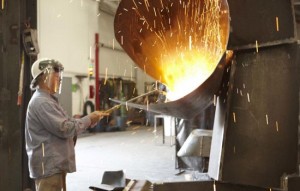 three sculptures for the National Harbor development near Washington D.C., a 130’ long archway named Animals Always for the St. Louis Zoo, a gate for the Cleveland Botanical Gardens in Cleveland, Ohio, a sculptural relief for Wellington Place, Toronto, Canada, a sculpture named Threshold for the Corporate Headquarters of Klein
three sculptures for the National Harbor development near Washington D.C., a 130’ long archway named Animals Always for the St. Louis Zoo, a gate for the Cleveland Botanical Gardens in Cleveland, Ohio, a sculptural relief for Wellington Place, Toronto, Canada, a sculpture named Threshold for the Corporate Headquarters of Klein 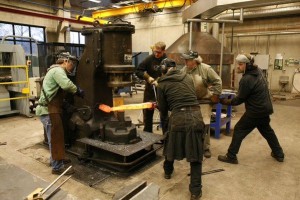 Steel, Rochester, N.Y., and a ceremonial entranceway called Transformation for Iowa State University in Ames, Iowa.
Steel, Rochester, N.Y., and a ceremonial entranceway called Transformation for Iowa State University in Ames, Iowa.
Pieces by Albert Paley can be found in the permanent collections of many major museums including the Metropolitan Museum of Art in New York, the Museum of Fine Arts in Boston, the 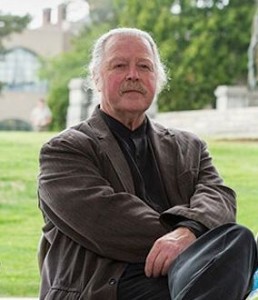 Museum of Fine Arts in Houston, and the Victoria and Albert Museum in London.
Museum of Fine Arts in Houston, and the Victoria and Albert Museum in London.
Broadly published and an international lecturer, Paley received both his BFA and MFA from the Tyler School of Art in Philadelphia. He received honorary doctorates from the University of Rochester in 1989, the State University of New York at Brockport in 1996, and St. Lawrence University, in Canton, New York in 1997. He also holds an endowed chair at the Rochester Institute of Technology.
Comprehenvise List of Paley Monumental Sculptures
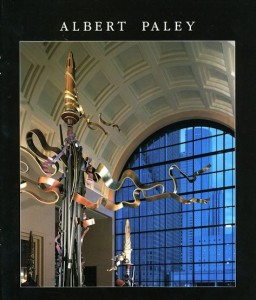 The following is a comprehensive list of Albert Paley’s most important monumental works:
The following is a comprehensive list of Albert Paley’s most important monumental works:
- 1974: Gates Portal, Renwick Gallery of the Smithsonian American Art Museum in Washington DC
- 1976: Hunter Fence, Hunter Museum of American Art in Chattanooga (Tennessee)
- 1980: Portal Gates, New York State Chambers in Albany (New York)
- 1981: Push Plate, Collection Metropolitan Museum of Art in New York
- 1984: Conclave, State University of New York at Brockport (New York)
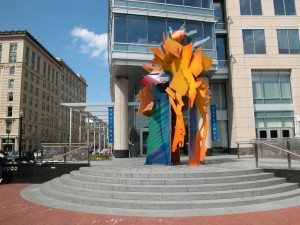 1987: Synergy, Ceremonial Archway in Philadelphia
1987: Synergy, Ceremonial Archway in Philadelphia- 1989: Main Street Bridge Railing, Rochester Bridge in Rochester
- 1990: Aurora, Roanoke Airport in Roanoke (Virginia)
- 1990: Olympia, AT & T Promenade II in Atlanta ( Georgia )
- 1991: Moment, Peter Kiewit Foundation
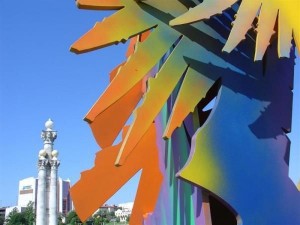 Sculpture Garden of the Joslyn Art Museum in Omaha (Nebraska)
Sculpture Garden of the Joslyn Art Museum in Omaha (Nebraska) - 1991: Ceremonial Gate, Arizona State University in Phoenix (Arizona)
- 1995: Passage, U.S. Federal Building in Ashville (North Carolina)
- 1996: Genesee Passage, Bausch & Lomb in Rochester HQ
- 1996: Apollo, DeCordova Museum and
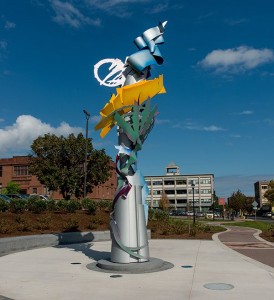 Sculpture Park in Lincoln (Massachusetts)
Sculpture Park in Lincoln (Massachusetts) - 1997: Gnomon, Ohio State University in Columbus (Ohio)
- 1998: Symbion, University of Toledo in Toledo (Ohio)
- 1998: Horizon, Adobe Systems Inc.. in San Jose (California)
- 1999: Stadium Gates, Forida State University in Tallahassee
- 2000: Portal Gates, Naples Museum of Art in Naples (Florida)
- 2002: Constellation ( relief ), Wellington Place in
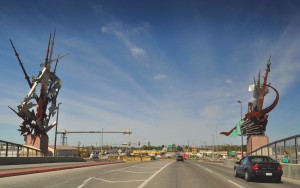 Toronto (Canada)
Toronto (Canada) - 2003: Sentinel, Rochester Institute of Technology in Rochester
- 2004: Kohl Gate, Cleveland Botanical Gardens in Ohio
- 2005: Gates Memphis, Brooks Museum of Art in Memphis (Tennessee)
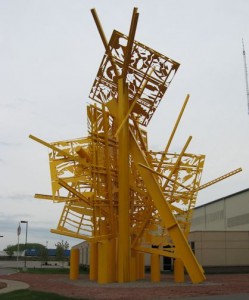 2006: Threshold, Klein Steel Service in Rochester
2006: Threshold, Klein Steel Service in Rochester- 2006: Animals Always, St. Louis Zoo in Saint Louis (Missouri)
- 2007: Gate, Washington National Cathedral in Washington DC
- 2008: Village of Hope in Tustin (California)
- 2009: Evanesce, sculpture trail Escultórica Ruta del Cemento y del Acero in Monterrey (Mexico)
- 2009: “Clay Center” Charleston WV
- 2009: Naiad, St. Tropez and Beau Rivage Condominiums, Fort Myers, FL
Albert Paley: Forged Works Exhibition at Orlando’s Mennello’s Museum of Art gives locals chance to meet sculptor (02-07-16)
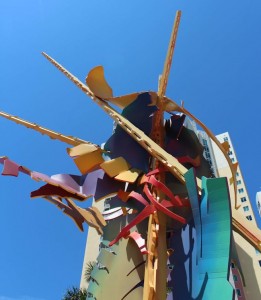 Southwest Florida residents and visitors are familiar with Rochester metal sculptor Albert Paley. He has four works interspersed throughout Fort Myers and Naples, including Cross Currents on the campus of Florida Gulf Coast University, Completed in 2009, Naiad in the entrance of the St. Tropez and Beau Rivage condominium complexes on the Caloosahatchee River, The Paley Gates on the gray marble entry to the Patty & Jay Baker Naples Museum of Art the ornate handles for the lobby doors of the Philharmonic Center for the Arts. But few have had the chance to actually meet the sculptor or hear him discuss
Southwest Florida residents and visitors are familiar with Rochester metal sculptor Albert Paley. He has four works interspersed throughout Fort Myers and Naples, including Cross Currents on the campus of Florida Gulf Coast University, Completed in 2009, Naiad in the entrance of the St. Tropez and Beau Rivage condominium complexes on the Caloosahatchee River, The Paley Gates on the gray marble entry to the Patty & Jay Baker Naples Museum of Art the ornate handles for the lobby doors of the Philharmonic Center for the Arts. But few have had the chance to actually meet the sculptor or hear him discuss 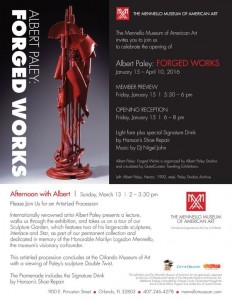 his art. But everyone will have that chance in March …. provided they are willing to make the 2-hour drive to Orlando.
his art. But everyone will have that chance in March …. provided they are willing to make the 2-hour drive to Orlando.
On Sunday, March 13, Paley will give a lecture at the Mennello Museum of Art, lead a walk through the Albert Paley: Forged Works exhibition it is hosting, and take a tour of the museum’s Sculpture Garden that features two of his large-scale Sculptures, Interlace and Star, which are part of the permanent collection and dedicated in memory of the Honorable Marilyn Logsdon Mennello, the museum’s visionary co-founder. The artist-led procession will conclude at the Orlando Museum of Art with a viewing of Paley’s sculpture Double Twist.
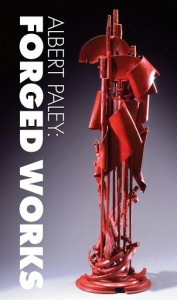 Albert Paley: Forged Works opened at the Mennello Museum of Art on January 15. The exhibition incorporates recent works the internationally acclaimed artist completed in the forged process alongside earlier pieces and drawings. Included in this exhibition are several sculptures completed at Steneby, The School of Craft and Design at the University of Gothenburg, Sweden and other smaller works that exemplify Albert Paley’s mastery of the forged technique. Exquisite drawings produced for finished works show the depth of his process, taking the idea from two-dimensional forms to three-dimensional.
Albert Paley: Forged Works opened at the Mennello Museum of Art on January 15. The exhibition incorporates recent works the internationally acclaimed artist completed in the forged process alongside earlier pieces and drawings. Included in this exhibition are several sculptures completed at Steneby, The School of Craft and Design at the University of Gothenburg, Sweden and other smaller works that exemplify Albert Paley’s mastery of the forged technique. Exquisite drawings produced for finished works show the depth of his process, taking the idea from two-dimensional forms to three-dimensional.
“Albert Paley: Forged Works presents Paley’s commitment to the material, method, form and subject,” states the Mennello Museum. “This gathering 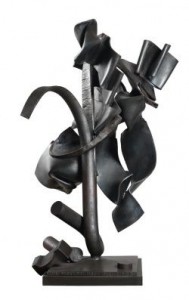 of work represents interplay of line and an expressive vitality through the dynamism that exists between rational thought and emotional expression, geometric and organic form, and ancient techniques and art nouveau aesthetics.”
of work represents interplay of line and an expressive vitality through the dynamism that exists between rational thought and emotional expression, geometric and organic form, and ancient techniques and art nouveau aesthetics.”
Paley has continually pushed the boundaries of his work, its process and materials through several contexts. Forging steel in a form of plasticity and pliability, Paley addresses the transformational change of the material through tapering, swaging, splitting, upsetting and punching. The result is sculpture developed of organic form analogous to processes seen in nature, such as the development of organic form in response to gravity with the emphasis on transition through the quality of line.
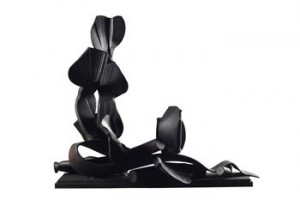 “We are delighted to present Albert Paley: Forged Works to our community,” says Shannon Fitzgerald, Executive Director, The Mennello Museum of American Art. “Paley is nationally recognized as a forerunner in monumental sculpture, and it is exciting to consider forging in this exhibition – an ancient method where metal is heated and reheated, strengthened and hammered –
“We are delighted to present Albert Paley: Forged Works to our community,” says Shannon Fitzgerald, Executive Director, The Mennello Museum of American Art. “Paley is nationally recognized as a forerunner in monumental sculpture, and it is exciting to consider forging in this exhibition – an ancient method where metal is heated and reheated, strengthened and hammered – 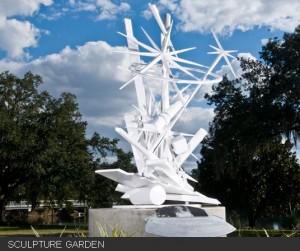 into such sinuous, extravagant curves that Paley achieves so brilliantly.”
into such sinuous, extravagant curves that Paley achieves so brilliantly.”
Paley’s use of steel can be described as industrial poetry, as evident in his large-scale sculptures Interlace and Star in the Mennello Museum’s Sculpture Garden.
Paley emerged in the mid-1960s as an artist goldsmith, and within a decade he became involved with the forging of steel. He is a long-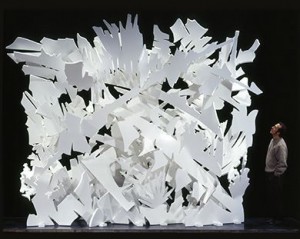 standing leader in the metal sculpture arena, where he is widely recognized for evolving blacksmithing into the realm of public art and commissions. Based in Rochester, New York, Paley has completed more than 60 international public and private site-specific works including the groundbreaking Portal Gates for the Renwick Gallery of the Smithsonian Institution in Washington, D.C. His work is in several museum
standing leader in the metal sculpture arena, where he is widely recognized for evolving blacksmithing into the realm of public art and commissions. Based in Rochester, New York, Paley has completed more than 60 international public and private site-specific works including the groundbreaking Portal Gates for the Renwick Gallery of the Smithsonian Institution in Washington, D.C. His work is in several museum 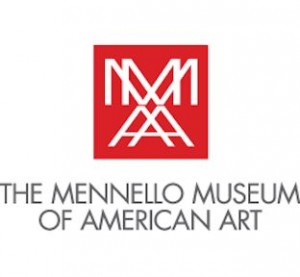 collections including the Metropolitan Museum of Art, New York, the Museum of Fine Arts, Boston, the Museum of Fine Arts, Houston, and the Victoria and Albert Museum and British Museums, London. Paley is the first metal sculptor to receive the coveted Institute Honors awarded by the American Institute of Architects, the AIA’s highest award to a non-architect.
collections including the Metropolitan Museum of Art, New York, the Museum of Fine Arts, Boston, the Museum of Fine Arts, Houston, and the Victoria and Albert Museum and British Museums, London. Paley is the first metal sculptor to receive the coveted Institute Honors awarded by the American Institute of Architects, the AIA’s highest award to a non-architect.
The festivities on March 13 start at 2:00 p.m. and end 90 minutes later at 3:30. For more information, please telephone 407-246-4278.
N.Y.C. Park Avenue Project
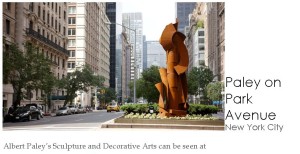 On June 29, 2013, Paley unveiled his latest sculpture project, the installation of not one, but 13 separate sculptures at various sites along Manhattan’s prestigious Park Avenue. “There can be few exhibition platforms in the world to equal the distinction, visibility and excitement of Park
On June 29, 2013, Paley unveiled his latest sculpture project, the installation of not one, but 13 separate sculptures at various sites along Manhattan’s prestigious Park Avenue. “There can be few exhibition platforms in the world to equal the distinction, visibility and excitement of Park 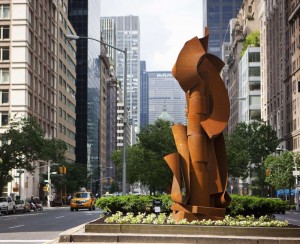 Avenue,” acknowledged Paley about the high profile outdoor exhibition, which runs through November 8, 2013.
Avenue,” acknowledged Paley about the high profile outdoor exhibition, which runs through November 8, 2013.
“With this series of sculptures created especially for Park Avenue, [Albert Paley] firmly places his work and himself in the center of Manhattan,” states Patterson Sims, independent curator and member of the Sculpture Advisory Committee of The Fund for Park Avenue’s Temporary Public Art 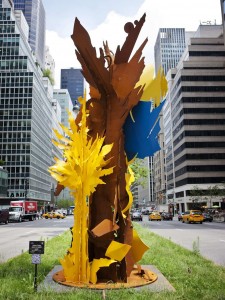 Collection, which arranged the exhibition. “With an ambition seldom matched in the series of Park Avenue sculpture installations, Paley has created a new body of work that celebrates the city and the site’s energy and takes his own fusion of delicacy, complexity, and monumentality to new heights.”
Collection, which arranged the exhibition. “With an ambition seldom matched in the series of Park Avenue sculpture installations, Paley has created a new body of work that celebrates the city and the site’s energy and takes his own fusion of delicacy, complexity, and monumentality to new heights.”
The Committee told Paley he could have all of Park Avenue, but he elected to consolidate the 13 sculptures he created for the exhibition between 52nd and 67th Streets because this area represents “the spectrum from the financial district, where the sculptures are bolder, through a residential area, where the sculptures are more detailed and intimate.”
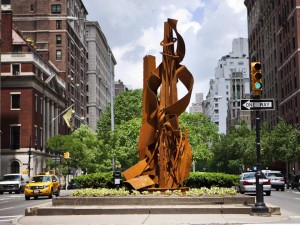 Although technically not site-specific, each sculpture has been strategically placed where its scale, proportion, color and composition best reflects the style and architecture of the surrounding buildings and the nature and volume of pedestrian and vehicular traffic. For example, the Seagram Building at 375 Park Avenue demanded a horizontal sculpture that accentuates the building’s open plazas. A horizontal piece
Although technically not site-specific, each sculpture has been strategically placed where its scale, proportion, color and composition best reflects the style and architecture of the surrounding buildings and the nature and volume of pedestrian and vehicular traffic. For example, the Seagram Building at 375 Park Avenue demanded a horizontal sculpture that accentuates the building’s open plazas. A horizontal piece 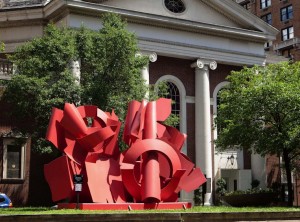 was also used in between 51st and 52nd to provide contrast with the vertical Byzantine lines of Bertram Goodhue’s Saint Bartholomew’s Church. By contrast, the wide intersection at 57th and Park required a pair of tall vertical sculptures to draw attention to the scale, vibrancy and frenetic energy that typify that section of Park Avenue.
was also used in between 51st and 52nd to provide contrast with the vertical Byzantine lines of Bertram Goodhue’s Saint Bartholomew’s Church. By contrast, the wide intersection at 57th and Park required a pair of tall vertical sculptures to draw attention to the scale, vibrancy and frenetic energy that typify that section of Park Avenue.
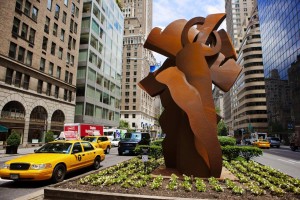 For each piece he created, Paley followed a rigorous planning process that began with the creation of an abundance of preliminary sketches and photographic renditions depicting how he expected each piece to interact with its adjoining site. The sketches were then translated into cardboard models called maquettes, which were subsequently replaced by 4-foot steel models that
For each piece he created, Paley followed a rigorous planning process that began with the creation of an abundance of preliminary sketches and photographic renditions depicting how he expected each piece to interact with its adjoining site. The sketches were then translated into cardboard models called maquettes, which were subsequently replaced by 4-foot steel models that 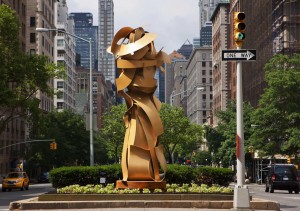 served as blueprints for fabrication of the thirteen pieces. In total, it took Paley and his team 14 months to fabricate the 750 separate pieces of metal weighing nearly 54 tons into the final sculptures. The completed pieces range in weight from 2.5 to 7.5 tons and in height from 10′ (Composed Presence) to 21 feet (Encore), with the longest (Progression) measuring more than 44
served as blueprints for fabrication of the thirteen pieces. In total, it took Paley and his team 14 months to fabricate the 750 separate pieces of metal weighing nearly 54 tons into the final sculptures. The completed pieces range in weight from 2.5 to 7.5 tons and in height from 10′ (Composed Presence) to 21 feet (Encore), with the longest (Progression) measuring more than 44 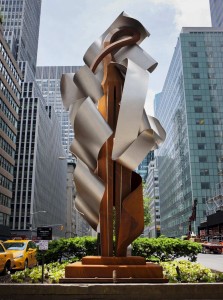 feet in length. Ironically, it took less time to install the completed sculptures on site (roughly 25 minutes each) than it took for the 10 flatbeds to travel the distance between Paley’s studios in Rochester and Park Avenue.
feet in length. Ironically, it took less time to install the completed sculptures on site (roughly 25 minutes each) than it took for the 10 flatbeds to travel the distance between Paley’s studios in Rochester and Park Avenue.
“So far, private collectors and museums have acquired 8 of the 13 sculptures,” advises Paley Studios Director Jennifer Laemlein. When the exhibition ends in November, the pieces that have been sold will be delivered to their purchasers. The others will be returned to Rochester, though it’s hard to imagine that any will be unspoken for by the time “Paley on Park Avenue” comes to an end.
The 13 sculptures and their locations include:
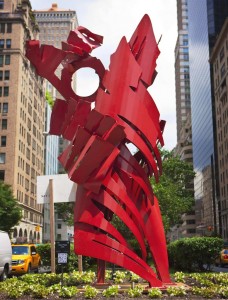 Progression, formed and fabricated painted steel, 9’4″ x 44’4.25″ x 4′; 52nd and Park;
Progression, formed and fabricated painted steel, 9’4″ x 44’4.25″ x 4′; 52nd and Park;- Between the Shadows, formed and fabricated painted and weathering steel, 18’5″ x 8’5″ dia.; 53rd and Park;
- Reflection, formed and fabricated painted steel, 18’9″ x 5’5″ x 5’2.5″; 54th and Park;
- Encore, formed and fabricated stainless and weathering steel, 20’11” x 8’2″ x 6’2.4″, 57th and Park;
- Jester, formed and fabricated painted steel, 18’9″ x 9′ x 7′; 57th and Park;
- Counter Balance, formed and fabricated weathering steel, 18’4″ x 11′ x 8’6″; 58th and Park;
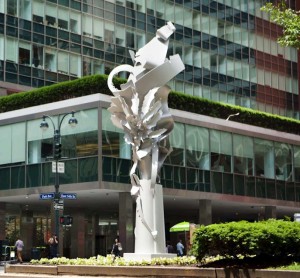 Variance, formed and fabricated painted steel, 16’11” x 12’10.5″ x 5’2″; 59th and Park;
Variance, formed and fabricated painted steel, 16’11” x 12’10.5″ x 5’2″; 59th and Park;- Titled Column, formed and fabricated weathering steel, 19’10” x 9’5″ x 7’11”; 60th and Park;
- Cloaked Intention, formed and fabricated weathering steel, 19’8″ x 8’7″; 61st and Park;
- Ambiguous Response, formed and fabricated weathering steel, 20’6″ x 6’8″ x 7’2″; 61st and Park;
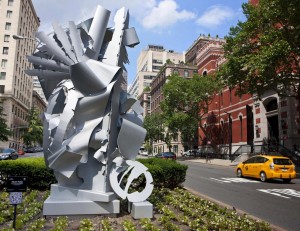 Composed Presence, formed and fabricated painted steel, 10′ x 13’6.5″ x 6’10”; 64th and Park;
Composed Presence, formed and fabricated painted steel, 10′ x 13’6.5″ x 6’10”; 64th and Park;- Languorous Repose, formed and fabricated painted steel, 14’8″ x 8’7.5″ x 5’9.75″; 66th and Park; and
- Envious Composure, formed and fabricated painted steel, 18’3″ x 7’6″ x 7′; 67th and Park.
Related Articles and Links.














 Tom Hall is both an amateur artist and aspiring novelist who writes art quest thrillers. He is in the final stages of completing his debut novel titled "Art Detective," a story that fictionalizes the discovery of the fabled billion-dollar Impressionist collection of Parisian art dealer Josse Bernheim-Jeune, thought by many to have perished during World War II when the collection's hiding place, Castle de Rastignac in southern France, was destroyed by the Wehrmacht in reprisal for attacks made by members of the Resistance operating in the area. A former tax attorney, Tom holds a bachelor's degree as well as both a juris doctorate and masters of laws in taxation from the University of Florida. Tom lives in Estero, Florida with his fiancee, Connie, and their four cats.
Tom Hall is both an amateur artist and aspiring novelist who writes art quest thrillers. He is in the final stages of completing his debut novel titled "Art Detective," a story that fictionalizes the discovery of the fabled billion-dollar Impressionist collection of Parisian art dealer Josse Bernheim-Jeune, thought by many to have perished during World War II when the collection's hiding place, Castle de Rastignac in southern France, was destroyed by the Wehrmacht in reprisal for attacks made by members of the Resistance operating in the area. A former tax attorney, Tom holds a bachelor's degree as well as both a juris doctorate and masters of laws in taxation from the University of Florida. Tom lives in Estero, Florida with his fiancee, Connie, and their four cats.